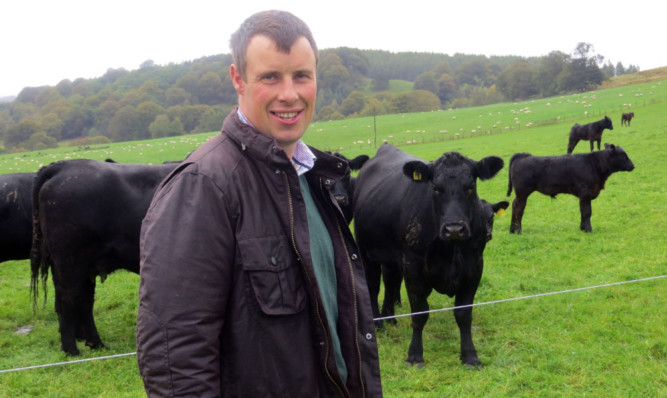A recent visit to Alex Brewster’s upland unit at Rotmell, in Perthshire, put paddock grazing systems under the spotlight for members of the Tayside Grazing Group.
The group, co-ordinated by Quality Meat Scotland, meets with the objective of improving livestock producers’ profitability, examining how to maximise the kilograms of meat produced from grass per hectare.
“When producing spring barley farmers always calculate yield per hectare. We’ve tried to make it easier to do the same for livestock production,” said Michael Blanche, QMS knowledge transfer specialist and meeting facilitator.
Rotmell, which extends to 1,000 hectares of upland and hill farming on a tenancy from Atholl Estates, is farmed by Mr Brewster in partnership with his parents Alastair and Morag.
They couple the farm acreage to a further 2,200ha managed through land management contracts and seasonal lets.
Currently stocking a herd of 120 suckler cows and a performance-recorded flock of 1,900 predominately Blackface ewes, their business is growing and livestock numbers are set to rise.
Mr Brewster became an early adopter of paddock grazing, taking up the system some 18 months ago. “We started with the summer-calving herd,” he said.
“They calved on an area of rough grazing as usual, but as soon as a batch of 25 cows and calves were ready, we moved them into a lane-grazing system with front and back wires.”
He said the transition has taught the family a great deal about managing residuals [the grass that remains after the stock has moved].
“A retaining electric wire is all that’s required to maintain the group, and we have installed a flexible water trough system that is moved to each new paddock with the cows and calves,” said Mr Brewster.
“We are currently moving the group every 48 hours and I find this to be an easy and pleasant task.
“The cows are pleased to see us and walk quietly into the next paddock, eager to graze on the lush grass and clover that is ahead of them.
“It’s a perfect way to check the herd and keep an eye out for any health or welfare problems at the same time.”
During the summer Mr Brewster also trialled a group of lambs on the system and, despite a few teething problems which are now rectified, he is confident that paddock grazing is the way forward in terms of increasing the performance of his flock.
“Our stock have adapted very well to the new system. I find it gives us much more control of the pasture, and the grass growth I have seen already is truly amazing.
“We forecast a five-figure reduction in the cost of fertiliser, which means we are lowering the costs of production considerably.
“Next year we plan to invest this saving on more electric fencing and water troughs to develop this further.”
Explaining the practicalities to the group was John Bailey of PasturSens, who said grazing in a ‘mob’ is very natural for ruminants, which will eat the best of the grass before moving on.
However, he said when you begin using this system on your own farm, you need careful consideration and planning and vigilant management of residuals will produce optimum results.
Taking stock into the paddock when there is 3,000kg of DM per hectare available and removing stock when this has reduced to 1,500kg of DM left is ideal, he said.
Keeping within this zone will normally be achieved between 24 and 72 hours of grazing, and farmers can learn to recognise the grass available in their own fields once they start using the system.
Overgrazing, however, is a risk.
“If the grass is deprived of sunlight due to removal of too many leaves, root activity will also be affected and regrowth will be diminished,” said Mr Bailey.
Undergrazing (leaving too much residual growth) will also result in rank areas and under performance.
For farmers wishing to start paddock grazing next spring, he advised drawing up a plan now that will be used to optimise the period of maximum grass growth during next spring and summer.
“The newly formed Grazing Groups represent professional and dynamic farmers whose enthusiasm for change really inspires me,” said Mr Bailey.
“In Scotland I have met many focused livestock managers eager to embrace a more technical approach to grazing.
“I would not be surprised if, by 2017, members of these groups are able to produce livestock performance from their grassland comparable with the top third of New Zealand farmers.”
